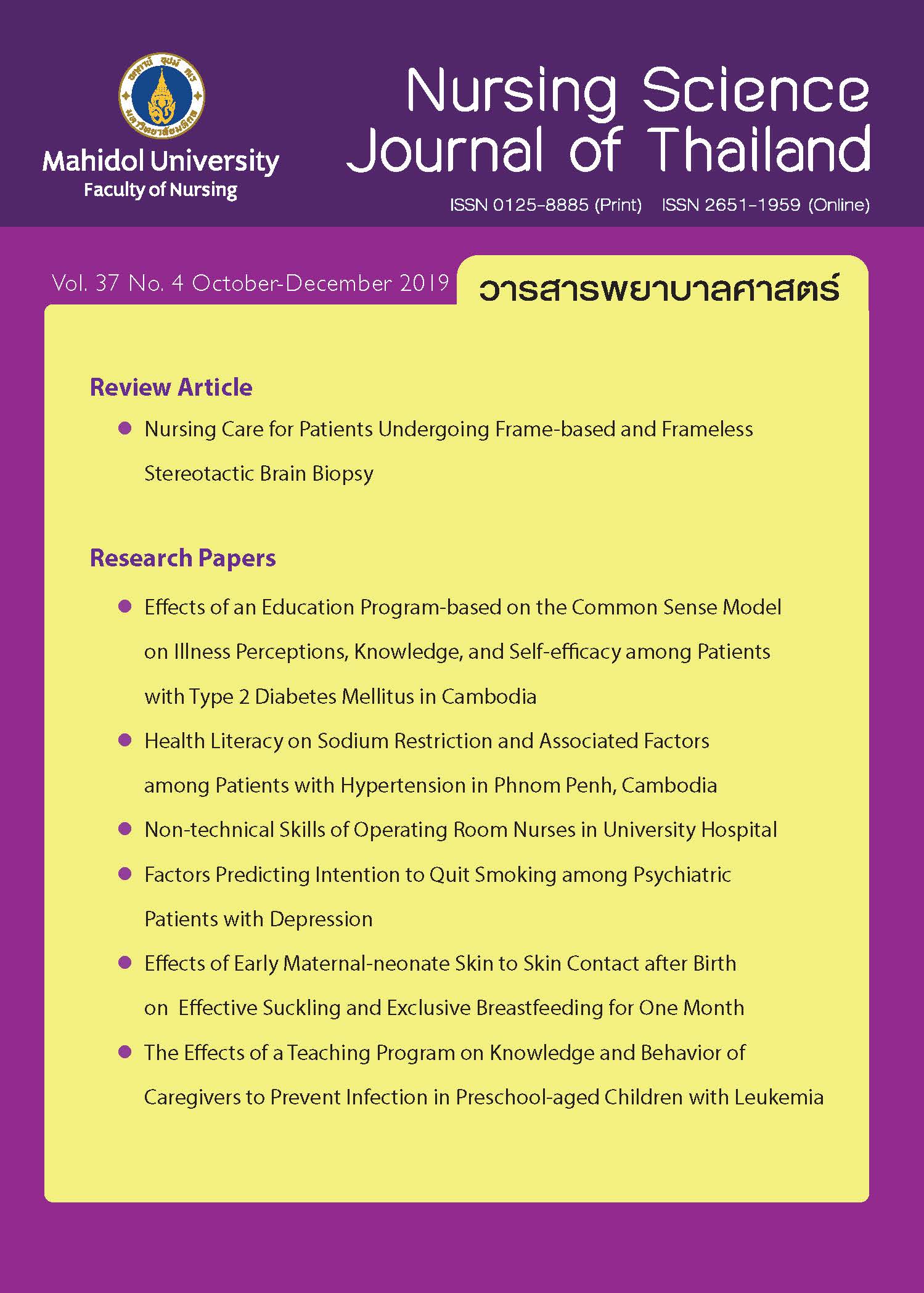Nursing Care for Patients Undergoing Frame-based and Frameless Stereotactic Brain Biopsy
Main Article Content
Abstract
In current times, there are an increased number of pathological brain tumor cases that require to be operated every year of which the most common disease is a brain tumor. In Siriraj hospital, brain tumor ranks number one compared to other five diseases of neurosurgery unit. Current treatment of brain tumor usually involves removal of tumor through various methods, such as craniotomy, awake craniotomy, endoscopic surgeries. Brain surgery is a complicated surgery, especially that involves removal of a deeper structures or dangerous areas, therefore it is necessary to correctly determine the location of the pathology in the brain without causing injury or destruction of other normal brain structures to reduce post-operative complications. Thus, stereotactic system is used to accurately guide the surgeon of the location and direction during surgery for safe removal of as much abnormal tissue as possible while leaving normal and healthy brain relatively intact, resulting in efficiency of the surgery.
Therefore, it is imperative that perioperative nurses have understanding and knowledge of surgical procedure and care management of this group of patients for patient safety and successful operation. Based on the authors’ experience in this field and the related literature review, this paper was written with the purpose to present the information of frame-based and frameless stereotactic brain biopsy and perioperative nursing care which would benefit to nurses who care for this group of patients.
Article Details
Copyright Notice: Nursing Science Journal of Thailand has exclusive rights to publish and distribute the manuscript and all contents therein. Without the journal’s permission, the dissemination of the manuscript in another journal or online, and the reproduction of the manuscript for non-educational purpose are prohibited.

Disclaimer: The opinion expressed and figures provided in this journal, NSJT, are the sole responsibility of the authors. The editorial board bears no responsibility in this regard.
References
2. Kongkham PN, Knifed E, Tamber MS, Bernstein M. Complications in 622 cases of frame-based stereotactic biopsy, a decreasing procedure. Can J Neurol Sci. 2008;35(1):79-84. doi: 10.1017/s0317167100007605.
3. Hickey JV. The clinical practice of neurological & neurosurgical nursing. 6th ed. Philadelphia, PA: Lippincott Williams & Wilkins; 2009. 768 p.
4. Khampitak K. Computer aided surgery. Srinagarind Medical Journal [Internet]. 2009 [cited 2019 Aug 30];24(2):167-72. Available from: https://www.smj.ejnal.com/e-journal/showdetail/?show_detail=T&art_id=1536. (in Thai).
5. Pillay PK. Image-guided intraoperative cranial localization. In: Andrews RJ, editor. Intraoperative neuroprotection. Philadelphia, PA: Lippincott Williams & Wilkins; 1996. p.395-422.
6. Rapalino O, Batchelor T, González RG. Intra-axial brain tumors. Handb Clin Neurol. 2016;135:253-74. doi: 10.1016/B978-0-444-53485-9.00014-3.
7. Millard NE, De Braganca KC. Medulloblastoma. J Child Neurol. 2016;31(12):1341-53. doi: 10.1177/0883073815600866.
8. Intharakamthonchai T. Secondary CNS Lymphoma. Thai Journal of Hematology and Transfusion Medicine. 2004;14(4):239-41. (in Thai).
9. Goodman T, Spry C. Essentials of perioperative nursing. 5th ed. Burlington, MA: Jones & Bartlett Learning; 2014. 376 p.
10. Kusum W. Critical care nursing: a holistic approach. 5th ed. Bangkok: Sahaprachapanich; 2013. 531 p. (in Thai).
11. American Association of Neurological Surgeons. Stereotactic brain biopsy [Internet]. Rolling Meadows, IL: American Association of Neurological Surgeons; 2019 [cited 2019 Aug 18]. Available from: https://www.aans.org/en/Patients/Neurosurgical-Conditions-and-Treatments/Stereotactic-Brain-Biopsy.

